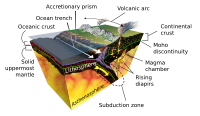
Photo from wikipedia
Seismic anisotropy records past and present tectonic deformations and provides important constraints for understanding the structure and dynamics of the Earth's interior. In this work, we use tremendous amounts of… Click to show full abstract
Seismic anisotropy records past and present tectonic deformations and provides important constraints for understanding the structure and dynamics of the Earth's interior. In this work, we use tremendous amounts of high‐quality Pwave arrival times from local and regional earthquakes to determine a high‐resolution tomographic model of 3‐D P wave azimuthal anisotropy down to 1,000‐km depth beneath East Asia. Our results show that trench‐parallel fast‐velocity directions (FVDs) are visible in the shallow portion of the subducting Pacific slab (<80 km), whereas the deeper portion of the Pacific slab mainly exhibits trench‐normal FVDs, except for the stagnant slab in the mantle transition zone (MTZ) where obvious NE‐SW FVDs are revealed. The FVDs in the subslab mantle change from a subduction‐parallel trend at depths of 80–400 km to a subduction‐normal trend in the MTZ. Large‐scale low‐velocity anomalies are revealed beneath the Philippine Sea plate where the FVD is NE‐SW. The FVDs along the Izu‐Bonin arc and in a slab gap exhibit a striking anticlockwise toroidal trend. All these features may reflect complex 3‐D flows in the mantle wedge due to tearing and dehydration processes of the subducting Pacific slab. The subducting Pacific slab is split at ~300‐km depth under the Bonin arc and then penetrates into the lower mantle, whereas under East Asia the Pacific slab becomes stagnant in the MTZ and reaches the North‐South Gravity Lineament in China. The intraplate volcanoes in East Asia are caused by hot and wet upwelling flows in the big mantle wedge above the stagnant Pacific slab.
Journal Title: Geochemistry, Geophysics, Geosystems
Year Published: 2019
Link to full text (if available)
Share on Social Media: Sign Up to like & get
recommendations!